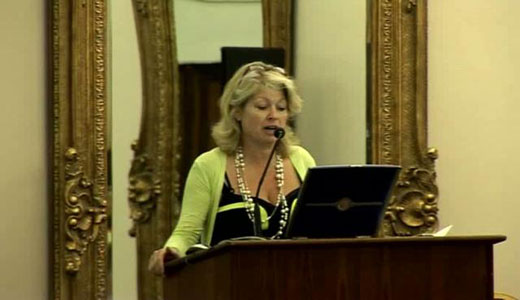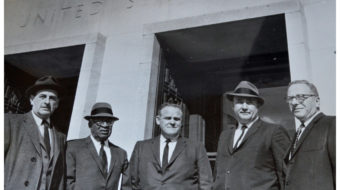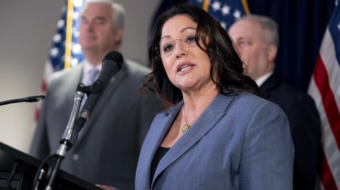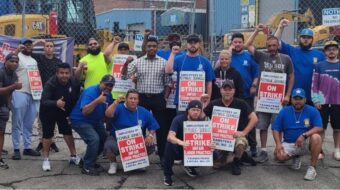
LOS ANGELES – Can you imagine battling the Great Recession by cutting the minimum wage?
It sounds unlikely, if not absurd, but that very scenario crashed down on Ireland’s unions and workers when the world economy collapsed five years ago. And similar such austerity schemes have plagued the four-million-person nation ever since.
That’s what Irish unions and workers face now, and toil to overcome, even as the Irish Labour Party is the minority partner in a new coalition government, a top Irish union leader says. And Ireland’s unions also must hold Labour to its promises, she adds.
Sallyanne Kinahan, Assistant General Secretary of the Irish Congress of Trade Unions, described that history and scenario in an interview with Press Associates Union News Service during the recent AFL-CIO Convention in Los Angeles. As the Irish federation’s number two official, Kinahan, one of 120 foreign trade unionists who attended the AFL-CIO conclave, has a top seat in Irish unions’ battle to pull workers from the slump.
Those efforts are held hostage to the austerity-driven crusade the 27-nation European Union imposed upon the Irish Republic (and Greece and Spain) with willing agreement from the former governing Fianna Fail Party and its Green Party partners.
In Ireland, the austerity included cutting the minimum wage from 8.65 Euros, then equal to $11, to 7.65 Euros, she says. Austerity champions also kept the two-million-person Irish labor market open, including to low-paid workers from Eastern Europe. “The trade unions weren’t consulted about that,” Kinahan notes, dryly.
How austerity-driven was the crusade that Irish unions faced? “Our crisis can’t be solved without a massive economic stimulus,” she says. “You had one in the U.S., however inadequate. We didn’t. Hello? They had no recognition of reality.
“The policies they advocated only increased the pain and suffering for many families. We’re really not recovering,” Kinahan comments.
That wasn’t all that Ireland’s unions and workers faced from the austerity emphasis.
Deregulation let the Irish banks overextend themselves, then crash. There was removal of “wage protection and wage advancement,” and the government blamed Ireland’s 250,000 public servants for fiscal ills, enacting “similar propositions and impacts” on public workers there as the right wing advocates and enacts here, she notes.
“But the big factors” in Ireland’s crash “were massive job losses in construction, which then spread to manufacturing, services and retail,” she explains.
Opening the Irish labor market may have worked when Ireland joined the EU in 2004 and the Irish economy, fueled by banking and real estate speculation, was booming and people were actually immigrating to Ireland for the first time in 150 years.
It didn’t in 2008 when Irish banks went bust, real estate values collapsed, joblessness zoomed from four percent to 14.5, and Ireland’s “best and brightest” young workers and college grads resumed emigrating, heading to the U.S., Canada, and Australia.
“The government was triumphant last month when unemployment went down by one percent to 13.5 percent,” Kinahan notes. “But those most affected are those with lower educational attainment, lower skills, and older workers.”
But it’s a new government, a combined Fine Gael-Labour coalition, that’s trying to clean up the wreckage left by Fianna Fail, whom it clobbered in the last election.
It’s also left the Irish Congress of Trade Unions considering other measures to help pull Ireland out of the ditch. Collective bargaining is unavailable in many cases. Kinahan explains Ireland is one of only three EU nations without the right to collective bargaining written into its constitution, and most of Ireland’s 180,000 businesses are small, “so extending unionism to them is practically impossible.”
That means the Irish union congress must negotiate on national issues, starting with lobbying their Labour Party allies to restore the minimum wage cut. “But for new entrants” to the labor force “the minimum wage is a maximum wage,” Kinahan says.
“The other thing we did is that through joint labor-management committees, we negotiated collectively agreed-upon pay for whole sectors – launderers, cleaners, painters and the like.” The catch is that after the committees also agreed on the wages, “four hours later the committees collapsed.”
The Irish unions and workers still face austerity-driven pressure, according to Jack O’Connor, president of the Service, Industrial, Professional, and Technical Union.
“It is quite clear there is a well-orchestrated campaign by those at the top of the banking system in Ireland and in Europe, who caused the crisis in the first place, to tighten the austerity screw to a degree that is not required even by their own criteria,” O’Connor wrote in his union’s monthly magazine, Liberty, which Kinahan cited.
“The government must demonstrate the nerves of steel required to face them down. Granted, the blackmailers have leverage, but we have some too because if our program fails then their whole project will collapse like a pack of cards,” he wrote.
Photo: Sallyanne Kinahan, Asst. Gen’l Secy of the Irish Congress of Trade Unions. Teachers Union of Ireland.










